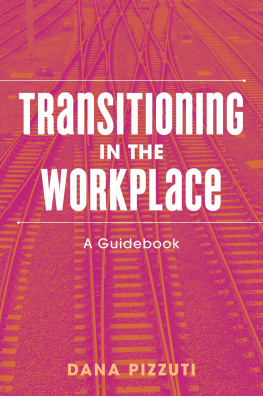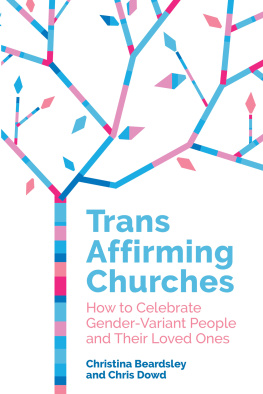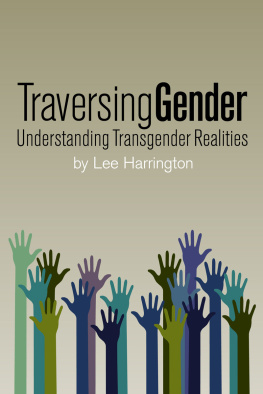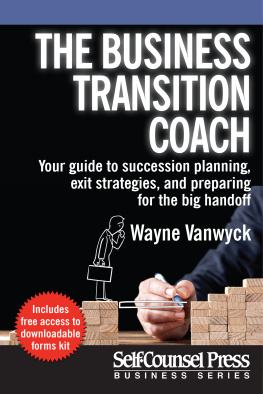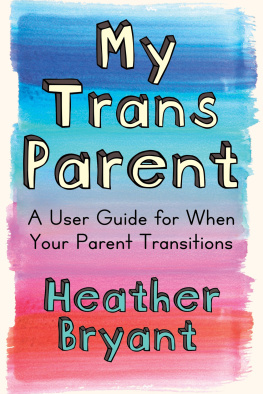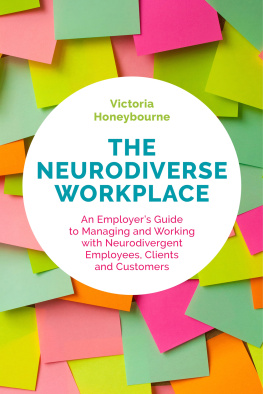
TRANSITIONING
IN THE
WORKPLACE
A Guidebook
DANA PIZZUTI

Jessica Kingsley Publishers
London and Philadelphia
CONTENTS
INTRODUCTION
Almost one percent of the United States (US) population identifies as transgender. Although this is a small percentage compared to the general population, it reflects an estimated 2.25 million people, many of whom are in the workforce and looking to stay there. Yet corporate America is significantly lacking in real and effective workplace guidelines that ensure transgender employees feel welcome and included. According to a 2011 report entitled Injustice at Every Turn: A Report of the National Transgender Discrimination Survey , transgender and gender non-conforming people face staggering rates of harassment, mistreatment, and discrimination at work. The most obvious sign of this discrimination is an extremely high unemployment rate: double that of the general population.
Worse, too few companies have policies in place for helping employees navigate the before-during-and-after experiences of a gender transition. Some of the most progressive companies may offer assistance for managing internal employee communications or clear health insurance guidelines, while others get the experience totally wrong, creating havoc in the workplace and feelings of hopelessness among the employees.
As a transgender rights advocate, I agree with the majority of experts in the field when they say that a lack of understanding of the transgender experience holds large and small companies back from achieving their financial goals. According to a 2015 Out Now Global LGBT+ 2020 Study, LGBT Diversity, Show Me The Business Case, there is a quantifiable benefit for businesses when LGBT+ employees are encouraged to come out to all co-workers within an inclusive environment. These benefits relate directly to employee retention. For instance, in the US alone, 67 percent of LGBT+ employees who ranked themselves as out to all in the workplace felt that colleagues treated them with respect and as a productive member of the team, compared to 38 percent who were not out to anyone at work.
Yet the total fraction of LGBT+ employees who are out at work in the US is still less than 40 percent. Worse, the data in the Out Now Global LGBT+2030 Study suggests that 21 percent of LGBT+ employees are still not out to anyone in their office. Fifty-five percent of transgender respondents believed that if they came out as trans at work, it would have a negative effect on prospects for future promotions. This number is further supported in the data where even 60 percent of out to all LGBT+ employees in Canada believed that they would have to leave their job in order to be promoted.
My hope is that we can change these statistics to make the workplace a more welcoming environment. I want to make the process of coming out and transitioning, especially in the workplace, as stress-free as possible. Considering the magnitude of the emotions behind it and the overwhelming scope of the changes facing the transitioning employee, I believe there is much employers can do, and those transitioning need to know that there are lots of options available and systems already in place that work. This book is meant to provide a supportive resource for both employers and employees. Had I had a book like this when I transitioned in 2015, I know that things would have gone a lot differently for me, and for my employer. In fact, I would probably still be working at that firm.
Ever since my transition I have been approached by many transgender individuals who want to know how I managed my transition and made it work as a senior executive in the conservative pharmaceutical industry. I wrote this book primarily for those who are contemplating or embarking on a transition, but also for their managers and human resources (HR) departments, so that everyone can have a better understanding of the physical and emotional issues transitioning employees face and can better support those employees as well as their co-workers. Think of it as a roadmap that offers specific guidance for what to expect inside and outside the workplace, how to anticipate, prepare for, and react to the most common situations, and how to minimize frustration and maximize career progress.
My transition
My story begins back when I was a teenager. I remember reading a newspaper article about a new surgery being performed at Johns Hopkins University. This was in the early 1970s, and the article was about a person who had a male-to-female sex change, and in that moment, I realized that I wished to be that person. Having soft lines, curves, breasts, a vaginaI wondered, what would that be like? Even though I was always attracted to girls, I never stopped wishing that I could be one. Whenever I was home alone, I would sneak into my parents room and try on my mothers bras and panties, including her realistic breast forms that she had had made following a mastectomy, which simulated the weight and feel of a real breast. This secret behavior continued intermittently throughout my adult life, through my undergraduate and medical schooling, two heterosexual marriages, two children, and a flourishing career.
It wasnt until I reached my late 50s that I realized I could no longer live on the sidelines of my own life. I could no longer just accept that I was a guy, and would have to make the best of it. At that time, I was working at a Fortune 100 pharmaceutical firm as a vice president. Although it might sound trite, Im good at my job, and at the time I was still enjoying working for that company. By 2015, I had been at there for eight years and had achieved remarkable success. I had grown my department from 120 people to over 400, and my team spanned 30 countries. I was busy setting new industry benchmarks for speed and efficiency, and the company was enjoying enormous success and recognition. Whats more, I felt we were really making a difference: the company had just obtained five new drug approvals in the previous two years, including two that would cure Hepatitis C, two new combination treatments for HIV (human immunodeficiency virus), and one for leukemia.
My marriage to my second wife was falling apart. When we agreed to separate, I realized I needed to figure out exactly what was going on with my identity. I had always told myself that if I was ever single again I would pursue the identity situation (maybe). Now was my chance and I seized it.
Without the internet, I dont think I would have been able to make decisions as quickly as I did. I found myself spending hours looking online for help, either through websites for the transgender community or YouTube videos which featured individual stories of transition, as well as more mundane issues such as how to apply cosmetics. Eventually I came across a website called Carlas: The Social Club, described as, A discreet, safe and private place for the transgender and cross-dressing community. The headline alone seemed very reassuring and private. It was located not too far from my home and offered makeovers, clothing, and a safe place to meet other trans men and women. I called and made an appointment for a consultation. This was the first time I had opened up about my gender confusion to anyone.
Aejaie Sellers was the proprietor of Carlas, having bought the business from Carla herself several years before. I learned that Aejaie was transgender and had transitioned when she was in her late teenage years. The first thing she asked me was if I had chosen a femme name. I didnt even know what she meant at first; I hadnt ever thought about it!
Next page
